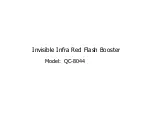
V1.02
Thom Hogan’s Complete Guide to the Nikon D300
Page 637
5.
Turn the remote flash units on. They all either need to
be connected to an SU-4 or have a built-in SU-4 type
of wireless mode selected.
6.
Take your picture. All the flashes should participate in
the exposure.
7.
Since the remote flash units may be more powerful
than the internal flash, you may have to adjust the
position of the external flashes to be further from the
subject (or use their diffusion domes to limit their
power). When I’m feeling especially daring and
creative, I actually set my exposure in Step #4 to
underexposure and then
try
to get the remote
Speedlights to fire a little hotter than the internal flash,
but this is a big trial and error process you’ll just have
to experiment with yourself.
External Flash Models for the D300
SB-400
The SB-400 is the simplest of the four external Speedlights
that can provide TTL flash with the D300. This small flash was
introduced with the D40 models in 2007.
Specifications
GN:
98 (ft), 30 (m) (at ISO 200)
Weight:
4.5 oz. (127g) (w/o batteries)
Size:
2.2” (56.5mm) tall x 2.6” (66mm) wide x 3.1” (80mm)
deep
Power:
two AA batteries
Recycle Time: 3.9 seconds minimum (full discharge)
# of Flashes:
~140
Flash Duration: 1/1300 at full output
Coverage:
18mm lens for DX, 27mm lens for FX
Case:
SS-400 included
Key Features:
TTL flash control on most i-TTL-capable Nikon bodies.
Rear curtain sync. Red-eye reduction. Head tilts from
horizontal up to 90 degrees above horizontal.















































